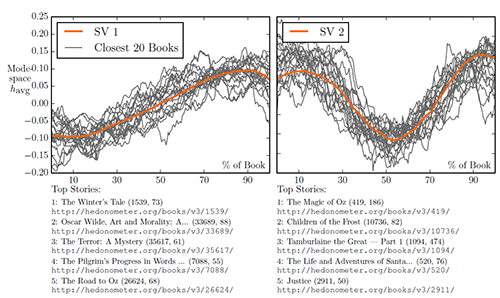Big data finds just six basic story arcs
How many stories are there? More narrowly, how many story-types can be written?
A research team led by Andrew Reagan, at the Computational Story Lab at the University of Vermont in Burlington, has tried to answer this question using big data algorithms. They used sentiment analysis to map the emotional arcs of some 1,400 stories and then used data-mining techniques to reveal the most common arcs.
These are:
+SV1. Rags to riches – a steady rise from bad to good fortune
-SV1. Riches to rags – a fall from good to bad, a tragedy
+SV2. Man in a hole – fall, rise
-SV2. Icarus – a rise then a fall
+SV3. Cinderella – rise, fall, rise
-SV3. Oedipus – a fall, a rise then a fall again
Note that there are actually only three patterns plus their inverses. Many novels will actually show a mixture of these basic patterns or a superposition of them, so that an overall rise may include minor setbacks.

There is also an interesting website, written by the same team, that analyses individual books - here is the hedonometric analysis of Shakespeare's Romeo and Juliet.
One amusing bit of analysis near the end of the paper, is that the most popular story-arcs in terms of books published are not the most popular in terms of sheer downloads.
The three most popular, in terms of downloads, are the Icarus-arc, the Oedipus-arc and the double Man-in-a-hole-arc. The latter follows the path of an early success, followed by a tragedy, but then ends with a positive resolution; the other two both end on a downer!

Seems like the popularity of the happy-ever-after story lies more with the writers than the public. The researchers may have unwittingly resolved this seeming dilemma, when they state in their Introduction that, "We tend to prefer stories that fit into the molds which are familiar, and reject narratives that do not align with our experience."
But why would mathematics departments be interested in analysing novels?
"Our approach could be applied in the opposite direction: namely by beginning with the emotional arc and aiding in the generation of compelling stories. Understanding the emotional arcs of stories may be useful to aid in constructing arguments and teaching common sense to artificial intelligence systems."
Ah... now we get it! Even the job of propagandist will not be immune to the AI onslaught.
The emotional arcs of stories are dominated by six basic shapes.
by Andrew J. Reagan, et. al. (2016)
pdf - arxiv
Image from article pdf, fair use.
Data Mining Reveals the Six Basic Emotional Arcs of Storytelling, MIT Technology Review, 2016.
Every story in the world has one of these six basic plots, BBC.com, 2018
Image: Mourning for Icarus from wikimedia
 - -
- -  - -
- -Please Comment, Resteem and Upvote. Thanks!
Instructions to request to join MAP are here
Check out MAP Rewarder for passive income!
@rycharde manages the AAKOM project and the MAP project.
quite interesting, ty (-:
Thanks! I have a litter of unfinished articles - glad this one stumbled across the finishing line.
You got a 3.46% upvote from @upme thanks to @rycharde! Send at least 3 SBD or 3 STEEM to get upvote for next round. Delegate STEEM POWER and start earning 100% daily payouts ( no commission ).
This was interesting to me, it also makes a lot of sense. I happen to think that far too many 'classic' stories end on a downer.
Keep up the good work ;p